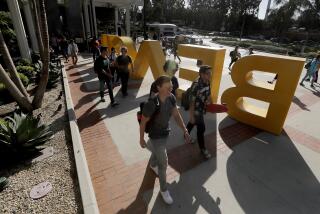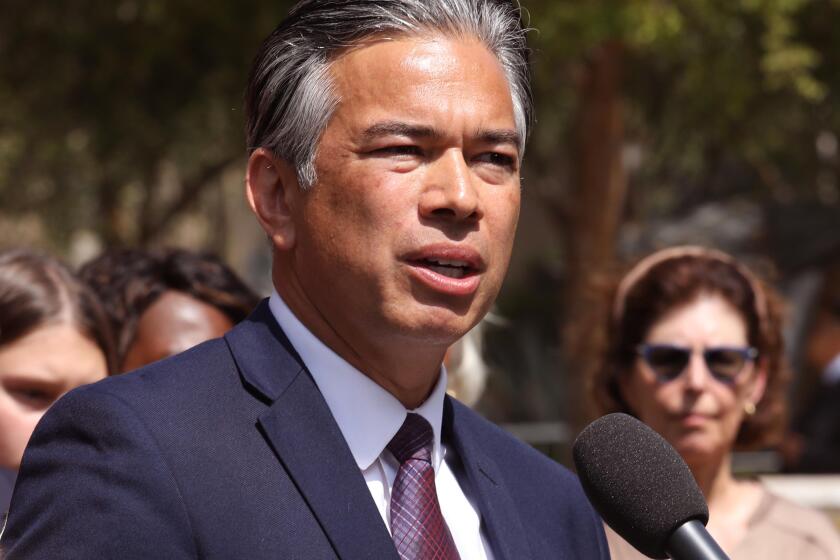California officials detail Trump funding freeze ‘chaos,’ warn another could cripple state

- Share via
- In court filings, California state and local officials have described “chaos” erupting after the Trump administration initiated a federal funding freeze.
- While funding has largely resumed amid ongoing litigation, officials say they fear future freezes, undertaken without careful planning through Congress, will be devastating.
Maricela Ramirez was at an education conference in Washington, D.C., at the end of January when she and other attendees heard the startling news: Federal funding for Head Start programs, which provide early-learning and nutritional support for low-income children nationwide, had been frozen.
Ramirez, chief education officer for the Los Angeles County Office of Education, quickly contacted colleagues and realized it was true. They had tried to make a routine withdrawal of millions of dollars in funding the day prior, but it hadn’t arrived overnight as expected.
Ramirez said “stress and panic” quickly began to set in, both in her office and among the conference attendees all around her.
“Our team had to assess whether LACOE would have to shut down its programs and to determine where LACOE could find funding to pay its employees if the system continued to be down,” Ramirez recently wrote in a legal filing. Pauses in federal funding could disrupt mental health services, counseling, health screening and nutritional support for up to 8,000 children, she added.
Ramirez’s account of the fallout and ongoing fear caused by the Trump administration’s sudden decision to halt billions of dollars in federal financial aid last month was one of more than 125 declarations of harm filed as part of a multi-state lawsuit challenging the freeze in U.S. District Court. At least 16 declarations came from California.
Some Head Start programs are struggling to continue services as funding delays hit. The delays come after Trump walked back on an effort to freeze federal grants.
Together, the declarations paint a picture of alarm and chaos in the hours and days after the White House budget office announced the freeze in a Jan. 27 memo, and of lingering fear and uncertainty as the Trump administration continues to fight for such budget authority in court.
While the administration rescinded the Office of Management and Budget memo two days after it was issued amid substantial public uproar, some funds remained frozen in the days that followed. And in response to the states’ lawsuit, the Trump administration argued that Trump and OMB “plainly have authority to direct agencies to fully implement the President’s agenda.”
U.S. District Judge John J. McConnell Jr. ordered Jan. 31 that the freeze be temporarily lifted while the litigation plays out. He further blocked it on Feb. 10, in part on the strength of the declarations — writing that the administration’s “categorical and sweeping freeze” was “likely unconstitutional and has caused and continues to cause irreparable harm to a vast portion of this country.”
The Trump administration accused McConnell of “intolerable judicial overreach,” but has backed off an appeal as the litigation continues.
In one declaration, Mary Halterman, an assistant program budget manager at the California Department of Finance, wrote that federal funding “typically comprises about a third” of the state’s budget. In fiscal 2024-25, the state’s $500-billion budget anticipates $168 billion in federal funds, not including funding for the state’s public college and university system.
The largest chunk, some $107.5 billion, is for payments under Medi-Cal, California’s version of Medicaid, which provides healthcare to nearly 15 million low-income Californians, or more than a third of the state’s population, Halterman wrote.
That includes about 5 million children — more than half of the kids in the state.
Congress also has allocated California $63 billion under the Infrastructure Investment and Jobs Act of 2021, and nearly $5 billion under the Inflation Reduction Act of 2022, “for programs related to public transportation, roads and bridges, water infrastructure, and broadband infrastructure, among others,” Halterman wrote.
The Office of Management and Budget’s funding freeze memo immediately created “confusion and doubt” as to California’s ability to continue providing such services, Halterman wrote. And that uncertainty was “ongoing,” she wrote.

“Without knowing whether and when federal dollars will be disbursed, state agencies may not be able to outlay those funds, causing immediate pause or potential termination of government services in some sectors,” Halterman wrote.
The freeze set off similar alarm bells among state officials overseeing Medi-Cal and other federally funded health programs, especially after they realized Jan. 28 that a $200-million payment hadn’t been received, wrote Lindy Harrington, an assistant state Medicaid director.
The department “managed to continue operations” that day, but “did not have sufficient funds to meet future financial obligations,” she wrote, and she now fears the “budgetary chaos” of a longer disruption — under which “health care services could be drastically curtailed or even cease altogether.”
As Gov. Gavin Newsom enters the second half of his final term, healthcare emerges as his most ambitious but glaringly incomplete initiative for Californians.
California officials overseeing other public health and safety programs raised similar fears after being locked out of funding for a range of environmental and infrastructure projects, including to clean up contaminated industrial sites, monitor air quality in low-income and disadvantaged communities and reduce dangerous and potentially deadly pollution along the busy freight corridor between Los Angeles and the Inland Empire.
Eric Lau, acting deputy director of the division of administrative services at the California State Water Resources Control Board, said his agency since 2021 has received hundreds of millions of dollars in federal grants for projects related to safe drinking water and overflow and stormwater management.
About 8 a.m. on Jan. 28, Lau‘s staff found only 31 of the board’s 45 grants were visible in its federal payment system, and searches for the 14 others produced an alarming message: “ERROR 839: No accounts found matching criteria.”
It took days for some of the accounts to come back online, Lau wrote, warning that longer disruptions could be catastrophic.
“The design, construction, and maintenance of critical water facilities will be stalled, risking continued water contamination, supply disruptions and severe threats to public health and the environment,” he wrote. “Ultimately, Californians’ right to safe, clean, affordable, and accessible water will be threatened.”
Federal funding also was temporarily blocked for researchers at California State University and University of California campuses, homeowners and contractors retrofitting homes to be more energy efficient, regulators overseeing workplace safety violations and job search assistance, career services, and training programs at dozens of local workforce development centers statewide.
Drastic cuts to National Institutes of Health ‘indirect funds’ for medical research has prompted deep concerns at UC over how to continue studies into ‘life-saving treatments.’
Both state and local officials warned that any cuts to federal funding that aren’t carefully considered by Congress and articulated in advance — giving localities time to draft new budgets of their own — are deeply unwise and potentially dangerous.
California Supt. of Public Instruction Tony Thurmond wrote that the state receives $7.9 billion in annual funding from the U.S. Department of Education, which supports 5.8 million students. The temporary freeze on funding last month did not disrupt school programs, in part because the state did not have any major draw on federal funds scheduled.
However, any interference to those funds moving forward would “do immeasurable harm” to educators and students, particularly low-income students and students with disabilities, he wrote.
For the current school year, the state is receiving $1.5 billion in direct funding for special education students, Thurmond wrote. In addition, public schools draw heavily on Medi-Cal — to the tune of millions of dollars per school per year — to provide additional therapies and mental and physical health services, Thurmond wrote.
California schools also receive huge amounts of federal funding under the Every Student Succeeds Act. This fiscal year, California was allocated $2 billion in ESSA funds to “meet the needs of some of its most vulnerable students,” and to ensure that they meet certain proficiency standards, Thurmond wrote. Among other things, it was allocated $120 million for the education of “migratory children,” $232 million to strengthen the quality and effectiveness of school staff, $157 million for English language acquisition and enhancement programs, and $152 million for improving school conditions and technology, Thurmond wrote.
California schools also spend $40 million to $50 million in federal funds per week to feed students through nutrition programs.
Another freeze “could cause layoffs, suspension of services to needy students and disruption of student learning supports,” Thurmond wrote.
State programs completely unrelated to education would also be put at risk, he wrote, given that many education programs are mandatory under state and federal law and the state would be forced to shuffle its resources around to provide them no matter what.
California Atty. Gen. Rob Bonta joined a coalition of more than 20 other states Friday in asking a federal court to once again intercede and force the Trump administration to unfreeze billions of dollars in federal funding.
Mason Matthews, chief budget and financial officer in L.A. County Chief Executive Fesia Davenport’s office, shared those wider budget concerns. The county is the most populated in the nation with about 10 million residents and a budget of about $49 billion, with an estimated $5.3 billion in federal funding.
Matthews wrote that the “exact ramifications” of the recent pause on federal funding “remain unknown,” but the risks posed by another freeze are high — threatening “a range of vital commitments to [county] residents including, but not limited to, healthcare, public safety operations, public benefits, workforce development, foster care, child support, housing and emergency management.”
One affected group would be needy families who receive cash assistance, employment services and child care through the state’s CalWORKS program, through which the county receives more than $2 billion in federal funds annually, Matthews wrote. Also at risk would be abused children, he wrote, as the county’s Department of Children and Family Services relies on $604.5 million in federal funding annually to investigate abuse and neglect and provide “supportive and therapeutic services” for such children.
More broadly, because federal funding amounts to about 10% of the county budget, another freeze would cause “significant budget and administrative burdens” for the county and “irreparably harm the day-to-day lives” of all county residents, Matthews wrote. That’s especially true given the budget strain already being felt from the devastating wildfires that incinerated parts of the county last month.
“The withholding of federal funding, coupled with the ambiguity and uncertainty regarding which funds will be withheld and for how long, will cause irreparable harm and jeopardize critical response and recovery efforts,” Matthews wrote. “Though the County will take appropriate actions to respond to the LA County Fires, without reimbursement from federal funding, other County crucial programs may be impacted such as housing options for homeless families and veterans.”
More to Read
Get the L.A. Times Politics newsletter
Deeply reported insights into legislation, politics and policy from Sacramento, Washington and beyond. In your inbox twice per week.
You may occasionally receive promotional content from the Los Angeles Times.















